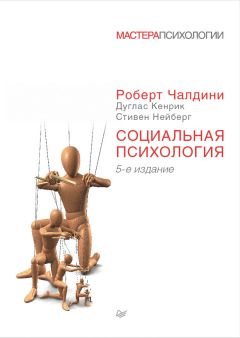Филип Зимбарго - Социальное влияние
MacCoun, R. J., and Kerr, N. L. (1988). Asymmetric influence in mock jury deliberations: Jurors' bias toward leniency. Journal of Personality and Social Psychology, 54, 21–33.
Maddux, J. E., and Rogers, R. W. (1983). Protection motivation and self — efficacy: A revised theory of fear appeals and attitude change. Journal of Experimental Social Psychology, 19, 469–479.
Malpass, R. S., and Devine, P. G. (1981). Eyewitness identification: Lineup instructions and the absence of the offender. Journal of Applied Psychology, 66, 345–351.
Handler, C, and Nakamura, Y, (1987). Aspects of consciousness. Personality and Social Psychology Bulletin, 13,299–313.
Mann, L., and Janis, I. L. (1968). A follow — up study on the long — term effects of emotional role playing. Journal of Personality and Social Psychology, 8, 339–342.
Manstead, A. S. R., Proffitt, C, and Smart, J. L. (1983). Predicting and understanding mothers' infant — feeding intentions and behavior: Testing the theory of reasoned action. Journal of Personality and Social Psychology, 44, 657–671.
Marbury, С. Н. (1989). An excursus on the biblical and theological rhetoric of Martin Luther King. In D. J. Garrow (Ed.), Martin Luther King, Jr.: Civil rights leader, theologian, orator (vol. 3). New York: Carlson.
Marcel, A. J. (1983). Conscious and unconscious perception: Experiments on visual masking and word recognition. Cognitive Psychology, 15, 197–237.
Maslach, C, Santee, R. Т., and Wade, С (1987). Individuation, gender role, and dissent: Personality mediators of situational forces. Journal of Personality and Social Psychology, 53, 1088–1093.
Maslach, C, Stapp, I., and Santee, R. T. (1985). Individuation: Conceptual analysis and assessment. Journal of Personality and Social Psychology, 49, 729–738.
McAlister, A. (1981). Antismoking campaigns: Progress in developing effective communications. In R. E. Rice and W. J. Paisley (Eds.), Public communication campaigns (pp. 91–103). Beverly Hills, CA: Sage.
McArthur, L.A. (1972). The how and what of why: Some determinants and consequences of causal attribution. Journal of Personality and Social Psychology, 22, 171–193.
McCullough. J.L., and Ostrom, Т. М. (1974). Repetition of highly similar messages and attitude change. Journal of Applied Psychology, 59, 395–397.
McGuire, W. J. (1964). Inducing resistance to persuasion: Some contemporary approaches. In L. Berkowitz (Ed.), Advances in experimental social psychology (vol. 1). New York: Academic Press.
McGuire, W.J. (1968). Personality and attitude change: An information processing theory. In A. G. Greenwald, Т. С Brock, and Т. М. Ostrom (Eds.), Psychological foundations of attitudes (pp. 171–196). New York: Academic Press.
McGuire, W.J. (1985). Attitudes and attitude change. In G. Lindzey and E. Aronson (Eds.), Handbook of social psychology: Volume II (3d ed., pp. 233–346). New York: Random House.
McGuire, W. J., and Papageorgis, D. (1961). The relative efficacy of various types of prior belief — defense in producing immunity against persuasion. Journal of Abnormal and Social Psychology, 62, 327–337.
McHugo, G. J., Lanzetta, J. Т., Sullivan, D. G., Masters, R. D., and Englis.B.G. (1985). Emotional reactions to a political leader's expressive displays. Journal of Personality and Social Psychology, 49, 1513–1529.
McPherson, K. (1983). Opinion — related information seeking: Personal and situational variables. Personality and Social Psychology Bulletin, 9, 116–124.
Mehrabian,A. (1972). Nonverbal communication. Chicago: Aldine — Atherton.
Mehrabian, A. (1981). Silent messages: Implicit communication of emotions and attitudes (2d ed.). Belmont, CA: Wadsworth.
Mehrabian, A., and Williams, M. (1969). Nonverbal concomitants of perceived and intended persuasiveness. Journal of Personality and Social Psychology, 13, 37–58.
Meyer, A. J., Nash, J. D., McAlister, A. L., Macco — by, N., and Farquhar, J. W. (1980). Skills training in a cardiovascular health education campaign. Journal of Consulting and Clinical Psychology, 48, 129–142.
Meyerowitz, В. Е., and Chaiken, S. (1987). The effect of message framing on breast self examination attitudes, intentions, and behavior. Journal of Personality and Social Psychology, 52,500–510.
Milgram, S. (1963). Behavioral study of obedience. Journal of Abnormal and Social Psychology, 67, 371–378.
Milgram, S. (1965). Some conditions of obedience to authority. Human Relations, 18, 57–76.
Milgram, S. (1974). Obedience to authority. New York: Harper & Row.
Millar, M. G., and Tesser, A. (1986). Effects of affective and cognitive focus on the attitude — behavior relationship. Journal of Personality and Social Psychology, 51, 270–276.
Miller, A. G. (1986). The obedience experiments: A case study of controversy in the social sciences. New York: Praeger.
Miller, G. A. (1962). Psychology: The science of mental life. New York: Harper & Row.
Miller, K.D. (1986). Martin Luther King, Jr., borrows a revolution: Argument, audience, and implications of a secondhand universe. College English, 48, 249–265.
Miller, N.E. (1978). Biofeedback and visceral learning. Annual Review of Psychology, 29, 373–404.
Miller, N., and Campbell, D. T. (1959). Recency and primacy in persuasion as a function of the timing of speeches and measurement. Journal of Abnormal and Social Psychology, 59, 1–9.
Milter, N., Maruyama,G., Beaber,R.J., and Valone, K. (1976). Speed of speech and persuasion. Journal of Personality and Social Psychology, 34, 615–624.
Milmoe.S., Rosenthal, R., Blane,H.T., Cha — fetz,M.E., and Wolf, E. (1967). The doctor's voice: Predictor of successful referral of alcoholic patients. Journal of Abnormal Psychology, 72, 78–84.
Mitchell, H. E. (1979). Informational and affective determinants of juror decision making. Unpublished doctoral dissertation, Purdue University. Molko v. Holy Spirit Association, 179 Cal. 3d 450; Daily Journal D. A. R. 13197 (1988).
Mooney, H., Bradbury, C, and Folmer, K. (1990). The efficacy of four persuasion techniques in four conceptually different situations. Paper presented at the meeting of the Western Psychological Association, Los Angeles, CA.
Moore, Т. Е. (1982). Subliminal advertising: What you see is what you get. Journal of Marketing, 46, 38–47.
Moreland, R. L„and Zajonc, R. B. (1979). Exposure effects may not depend on stimulus recognition. Journal of Personality and Social Psychology, 37, 1085–1089.
Moriarty, T. (1975). Crime, commitment and the responsive bystander: Two field experiments. Journal of Personality and Social Psychology 31,370–376.
Morley, D. D. (1987). Subjective message constructs: A theory of persuasion. Communication Monographs, 54, 183–203.
Mosbach, P., and Leventhal, H. (1988). Peer group identification and smoking: Implications for intervention. Journal of Abnormal Psychology, 97, 238–245.
Moscovici, S. (1976). Social influence and social change. London: Academic Press.
Moscovici, S. (1980). Toward a theory of conversion behavior. In L. Berkowitz (Ed.), Advances in experimental social psychology (vol. 13, pp. 209–239). New York: Academic Press.
Moscovici, S., and Zavalloni, M.(1969). The group as a polarizer of attitudes. Journal of Personality and Social Psychology, 12, 125–135.
Mowen, J. C., and Cialdini, R. B. (1980). On implementing the door — in — the — Гасе compliance technique in a business context. Journal of Marketing Research, 17,253–258.
Mulbar, H. (1951). Interrogation. Springfield, IL: Thomas.
Mullen, В., Futrell, D., Stairs, D., Tice, D.M., Baumeister, R. F., Dawson, К. Е., Rior — dan.C.A., Radlojf.C.E., Goethals, G. R., Kennedy, J. G., and Rosenfeld,P. (1986). Newscasters' facial expressions and voting behavior of viewers: Can a smile elect a president? Journal of Personality and Social Psychology, 51,291–295.
Myers, D.G., and Kaplan, M.F. (1976). Group — induced polarization in simulated juries. Personality and Social Psychology Bulletin, 2, 63–66.
Myers, D.G., and Lamm, H. (1975). The group polarization phenomenon. Psychological Bulletin, 83, 602–627.
Neil v. Biggers, 409 U.S. 188 (1972).
Nelson, Z. P., and Mowry, D. D. (1976). Contracting in crisis intervention. Community Mental Health Journal, 12, 37–A3.
Nemeth, С J. (1986). Differential contributions of majority and minority influence. Psychological Review, 93, 23–32.
Nemeth, C. I., Mayseless, O., Sherman,]., and Brown, Y. (1990). Exposure to dissent and recall of information. Journal of Personality and Social Psychology, 58, 429–437.
Newcomb, Т. М. (1961). The acquaintance process. New York: Holt, Rinehart & Winston.
The New York Times (1990). U.S. tobacco ads in Asia faulted. P. J. Hilts (writer). May 5, p. 19.
The New York Times (1990). Killings in '89 set a record in New York. J. С McKinley (writer). Mar. 31.L27, L30. Newsday (1990). Mar. 28. News — week (1990). Feb. 5.
Nisbett, R.E., and Ross, L. (1980). Human inference: Strategies and shortcomings of social judgment. Englewood Cliffs, NJ: Prentice — Hall.
Nisbett, R. E., and Schachter, S. (1966). Cognitive manipulation of pain. Journal of Experimental Social Psychology, 2, 227–236.
Nisbett,R.E., and Wilson,Т.О. (1977a). Telling more than we can know: Verbal reports on mental processes. Psychological Review, 84, 231–259.
Nisbett, R. E., and Wilson, T. D, (1977b). The halo effect: Evidence for unconscious alteration of judgments. Journal of Personality and Social Psychology, 35, 250–256.
Nix, S. (1989). Weekend with the Moonies. San Francisco Chronicle, Aug. 10, Bl, ВЗ, В6.
Nizer, L. (1961). My life in court. New York: Pyramid.
Nord, W. (1970). Improving attendance through rewards. Personnel Administration, 33, 37–41
O'Barr, W.M. (1982). Linguistic evidence. New York: Academic Press.
Ofshe, R. (1990). Coerced confessions: The logic of seemingly irrational action. Cuitic Studies
Journal, 6, 1–15.
Oldenburg, D. (1990). High — tech sublinguals: You are what you hear. The Washington Post, Apr. 19, ВЗ, В5.
Osborne, J. G., and Powers, R. B. (1980). Controlling the litter problem. In G. L. Martin and J. G. Osborne (Eds.), Helping the community: Behavioral applications. New York: Plenum.
Osgood, С. Е, Suci, G. J., and Tannenbautn, P. G. (1957). The measurement of meaning. Urbana: University of Illinois Press.
Ostrom, T.M., and Brock, Т. С. (1968). A cognitive model of attitudinal involvement. In R. P. Abelson, E. Aronson, W. J.McGuire, Т. М. Newcomb, M. J. Rosenberg, and P. H. Tannenbaum (Eds.), Theories of cognitive consistency: A sourcebook (pp. 373–389). Chicago: Rand McNally.
Packard, V. (1957). The hidden persuaders. New York: McKay.
Packwood, W. T. (1974). Loudness as a variable in persuasion. Journal of Counseling Psychology, 21, 1–2.
Page, B, I., Shapiro, R. Y., and Dempsey, G. R. (1987). What moves public opinion? American Political Science Review, 81, 23–43.
Page, M. M. (1969). Social psychology of a classical conditioning of attitudes experiment. Journal of Personality and Social Psychology, 11, 177–186.
Page, M. M. (1974). Demand characteristics and the classical conditioning of attitudes experiment. Journal of Personality and Social Psychology, 30, 468–476.
Pallak.M.S., Mueller, M., Dollar, K., and Pal — lak, J. (1972). Effects of commitment on responsiveness to an extreme consonant communication. Journal of Personality and Social Psychology, 23, 429–436.
Papageorgis, D., and McGuire, W. (1961). The generality of immunity to persuasion produced by pre — exposure to weakened counterarguments. Journal of Abnormal and Social Psychology, 62, 475–481.
Pennington, N.. and Hastie, R. (1986). Evidence evaluation in complex decision making. Journal of Personality and Social Psychology, 51, 242–258.
Per/man, D., and Oskamp, 5. (1971). The effects of picture content and exposure frequency on evaluations of negroes and whites. Journal of Experimental Social Psychology, 7, 503–514.
Peterson, C., and Seligman, M. E. P. (1984). Causal explanations as a risk factor for depression: Theory and evidence. Psychological Review, 91, 347–374.
Petty, R.E., and Cacioppo, J. T. (1977). Forewarning, cognitive responding, and resistance to persuasion. Journal of Personality and Social Psychology, 35, 645–655.
Petty, R. E., and Cacioppo, J. T. (1981). Attitudes and persuasion: Classic and contemporary approaches. Dubuque, 1A: Wm. С Brown.




